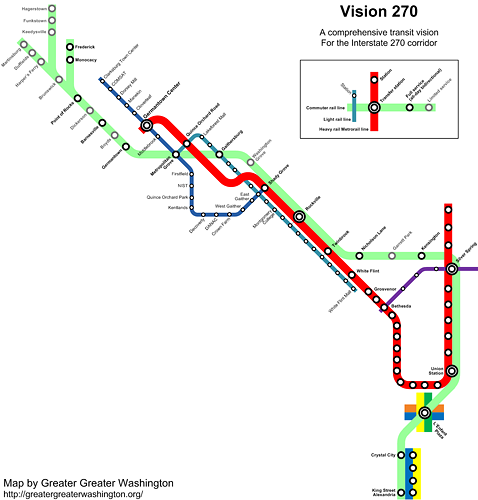Gaithersbungle, part 6: What else $3.8 billion could buy, more specifically
In Part 3, we looked at MARC expansion proposals, which would increase transit service in the I-270 corridor for much less than the $3.8 billion the Maryland State Highway Administration wants to spend to widen the freeway. The Action Committee for Transit came up with a more specific dream package of transit proposals, which I turned into a map.
This map includes the following:
- Extension of the Red Line to Germantown. The Red Line would use the I-370 and I-270 right-of-way from Shady Grove to Germantown, then end in an underground station at Germantown Town Center.
- All-day, bidirectional MARC service to Frederick. A new station near White Flint, to serve the planned, dense, transit-oriented development in that area. And through-routing of MARC trains down at least to King Street.
- A MARC extension to Hagerstown, using an old and abandoned right-of-way.
- The Corridor Cities Transitway, using the less circuitous original alignment and an extension to Clarksburg Town Center. With the Red Line, riders from north of Germantown wouldn’t have to ride all the way through the office parks west of Gaithersburg to get to Rockville, Bethesda or DC.
- A streetcar along Route 355 (Rockville Pike/Hungerford Dr/Frederick Rd) from the White Flint Mall to Gaithersburg. It would stop at the various Metro stations, Montgomery College, Gaithersburg MARC, and Lakeforest Mall before turning west to a new Red Line station and Metropolitan Grove MARC, where it would connect to the CCT.
According to ACT’s calculations, all of this, including light rail on both the CCT and the 355 line, would cost less than the current proposal to widen the freeway and build a bus rapid transit CCT. Plus, Maryland could build these individually instead of all-or-nothing.
Should Maryland execute this plan? It depends. If the state is intent on spending $4 billion in the 270 corridor, then this is far superior. Drivers would benefit, too, because this transit would shift enough trips off of I-270 that the existing road could handle the remaining auto trips.
However, this area isn’t the best place to put so many jobs and so much infrastructure at all. Eastern Montgomery County has been waiting for its transit for a long time. There are many development opportunities at Wheaton and Glenmont, and plenty of parts of Silver Spring still eager for the promised revitalization. Matt and Reza’s map showed how underutilized our existing infrastructure is in the east, especially in Prince George’s County. Between the planned development at White Oak and White Flint, Montgomery could already accommodate its expected growth for the next 20 years without a lot of new jobs way up there. There’s plenty of room for biotech growth in Baltimore, too, and they have an ambitious transit plan of their own.
The 270 widening is a bad idea for two reasons: it increases auto dependence, and shifts the epicenter of jobs and housing westward away from the developed part of the region and the state. An all-transit alternative would accomplish all of the mobility goals in the corridor for the same or less money. But the even smarter planning would put some of the transit and a little bit of the growth over on this side of the county, and put more in the other, better, and needier areas.
Previously:
- Part 1: Planning Board staff latest to ignore better way for Gaithersburg
- Part 2: Old, tired formulas generate old, disastrous solutions
- Part 3: What else can you get for $3.8 billion?
- Part 4: Why emulate Tysons’ existing road network?
- Part 5: What you callin’ a city?

